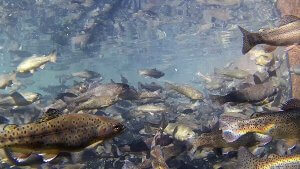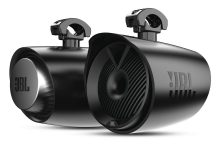AZGFD To Resume Stocking Apache Trout
The Apache Trout, one Arizona’s two native trout, are returning to lakes and streams in the White Mountains by May. The Arizona Game and Fish Department is scheduled to stock around 55,000 Apache trout of a catchable size from its Silver Creek Hatchery from May through September.
Stockings could not occur in 2017 due to federal hatcheries’ having tested positive for Bacteria Kidney Disease (BKD). The state relies on federal hatcheries to supply the eggs necessary to raise  .
.
Eggs Expected
This year, AZGFD is expecting to receive about 200,000 Apache trout eggs. AZGFD has around 100,000 Apache trout eggs (BKD free) at its Tonto Creek Hatchery that came from Williams Creek National Fish Hatchery and are scheduled to be stocked next year:
AZGFD typically stocks Apache trout into Lee Valley Reservoir, East Fork of the Black River, West Fork of the Black River (campground), West Fork of the Little Colorado River at Sheep Crossing (below Mt. Baldy), West Fork of the Little Colorado River in Greer, and Upper Silver Creek.
Catching The Trout
Apache trout can be caught by a variety of methods, including wet or dry flies, small lures, or natural baits, in either lakes or streams. Artificial flies produce the best results. Best natural baits tend to be worms or grasshoppers.
About Apache Trout (Oncorhynchus apache)
The Apache is one of Arizona’s two native trout species and is the Arizona state fish. Body color is yellowish-gold at the top of the head and the back is a dark olive. Dorsal, anal and pelvic fins are white tipped with dark, bold spots on dorsal and tail fin.
Spotting on the body is sparse and irregular and may extend below lateral line. Two small black spots on either side of pupil give appearance of black stripe through eye. Length: 6 to 24 inches. Weight: 6 ounces to almost 6 pounds.
Location And Habitat
Found only in White Mountain lakes and streams on forest and reservation lands. The Department is increasing their efforts in stocking Apache trout in Arizona and has an active recovery and management plan in place. The Apache trout is stocked from Silver Creek Hatchery in the summer months into the Little Colorado River near Greer, the Black River and Lee Valley Lake.
Reproduction
Apache trout typically spawn in early spring. Females excavate redds (nests) in the gravel; after fertilization the eggs are covered with gravel. They are generally sexually mature by age 3. Apache trout are capable of hybridizing with rainbow trout which has greatly reduced the range of pure strain Apaches.
Food/Table Quality
They feed on aquatic and terrestrial insects and invertebrates. The meat is firm, flaky and is considered fine eating. Removal of fine bones is difficult if fish is overcooked.
Angling Methods
Apache trout can be caught by a variety of methods, including wet or dry flies, small lures, or natural baits, in either lakes or streams. However, artificial flies produce the best results.
Wet Flies
Small hooks, in sizes 14 through 18, are usually better for Apache trout, especially throughout the day. Use patterns that have olive green, brown, or black coloring. Popular patterns include: Peacock Ladies; Pheasant-tail nymphs; Hares Ear nymphs; zug bugs; scuds; or stonefly, mayfly or caddis fly nymph imitations. Larger wet flies (size 6 to 8 hooks) that work well include wooly buggers, wooly worms, streamers, and muddler minnows. Colors in purple, black, brown, and green work best.
Dry Flies
Again, use small hook sizes. Best fishing times are at dawn and dust, or any other time fish are rising to the surface to feed. Popular patterns include: Royal Coachman; Adams; Royal Wulff; Parachute Adams; or any gnat, mosquito, mayfly caddisfly, or stonefly adult imitations.
Terrestrial Patterns
Use any grasshopper, ant, or beetle imitation. Pay attention to size when fishing hopper patterns.
Lures
Smaller spinners work best. Some to try are: Panther Martins, Super Dupers, or Rooster Tails.
Baits
Generally, bait will work to catch Apache trout if it looks natural. Use worms or grasshoppers. Some prepared baits can work at times.
Where To Fish: State Waters (A state fishing license and trout stamp are required.)
- Lee Valley Reservoir
- East Fork of the Black River More Arizona Rivers And Streams
- West Fork of the Black River (campground)
- Upper West Fork of the Black River (near Big Lake)
- West Fork of the Little Colorado River at Sheep Crossing (below Baldy)
- West Fork of the Little Colorado River in Greer
- Upper Silver Creek
- White Mountain Apache Waters (A tribal fishing permit is required.)
- HawleyLake More Arizona Lakes
- Pacheta Lake
- Christmas Tree Lake
- Bog Tank
- Hurricane Lake
- Shus Be Tou & Shus Be Zahze
- Earl Park Lake
- Horseshoe Lake
- Sunrise Lake
No matter what kind of fishing you are looking for Arizona has lots of diversity.
Arizona Lakes, Arizona Pros – Marc Townsend by Margie Anderson































